Students can use the Spectrum Math Grade 8 Answer Key Chapter 6 Pretest as a quick guide to resolve any of their doubts
Spectrum Math Grade 8 Chapter 6 Pretest Answers Key
Check What You Know
Answer the questions by interpreting data from the graph.

Question 1.
What two sets of data are being compared by this scatter plot?
Answer:
Test scores and Hours of study.
Explanation:
A scatter plot shows the relationship between two sets of data.
It is made up of points, Test scores and Hours of study.
The two sets of data are being compared by this scatter plot are Test scores and Hours of study.
Question 2.
Is the correlation positive or negative?
Answer:
Positive.
Explanation:
The above scatter plot shows the relationship between the Test scores and Hours of study.
We observe a positive relationship as the hours of study increase the test scores also increases.
Question 3.
What is a possible explanation for the outliers?
Answer:
A student was not studying effectively.
Explanation:
The above scatter plot shows the relationship between the Test scores and Hours of study.
Create a trend line by using a straight edge to draw a line across the points on a scatter plot.
To have the same number of points above and below the trend line while ignoring outliers.
Based on the outliers a student was not studying effectively.
Use the data set below to create a scatter plot with a line of best fit. Then, answer the questions.
Question 4.
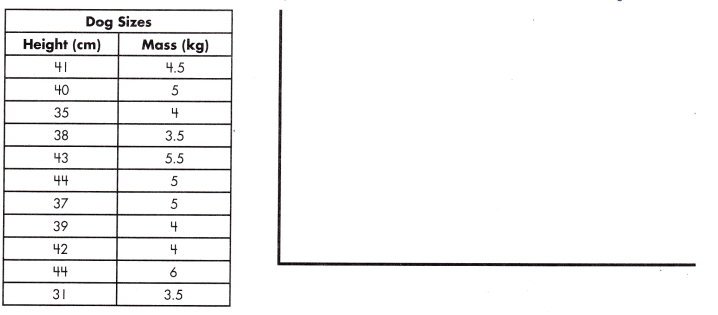
Answer:
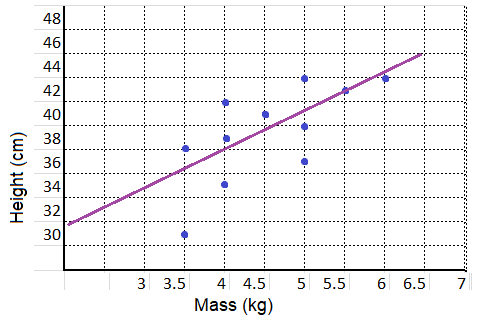
Explanation:
With reference to the above given data set,
A scatter plot shows the relationship between two sets of data.
It is made up of points as mass of dogs and heights of dogs.
The points are plotted by using the values from the two sets of data as coordinates.
This scatter plot shows the relationship between the mass of dogs and heights of dogs.
As one value increases, the other appears to increase as well.
This indicates a positive relationship.
Question 5.
What two sets of data are being compared by this scatter plot?
Answer:
Height of dogs and Mass of dogs.
Explanation:
As, we know that a scatter plot shows the relationship between two sets of data.
The two sets of data are being compared by the given scatter plot are the Height of dogs and Mass of dogs.
Question 6.
Is the correlation between the data sets positive or negative?
Answer:
Positive.
Explanation:
The above scatter plot shows the relationship between the Test scores and Hours of study.
We observe as trend line to upwards and a positive relationship as the Height of dogs increases and Mass of dogs is also increases.
Question 7.
What is a possible explanation for the outliers?
Answer:
Some dogs have a thinner build depending on their breed.
Explanation:
The above scatter plot shows the relationship between the Test scores and Hours of study.
Create a trend line by using a straight edge to draw a line across the points on a scatter plot.
To have the same number of points above and below the trend line while ignoring outliers.
Based on the outliers some dogs have a thinner build depending on their breed.
Question 8.
If a dog has a mass of 3 kg, predict the height of the dog.
Answer:
20 \(\frac{2}{7}\) centimeters.
Explanation:
With reference to the above graph, a dog has a mass of 3 kg,
then the predicted height of the dog is 20 \(\frac{2}{7}\) centimeters.
Use each set of bivariate data to create a scatter plot, trend line, and an equation that approximates the data set.
Question 9.
a.
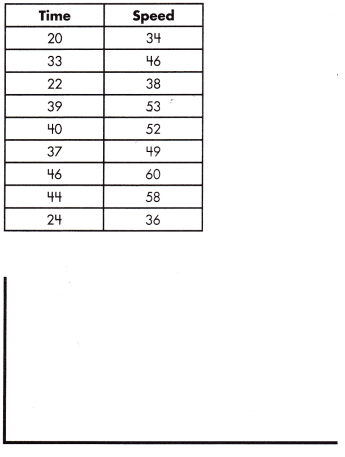
equation: ________________
Answer:
Equation:
y = \(\frac{11}{9}\) x + 6.67

Explanation:
With reference to the above given data set,
m = \(\frac{60 – 49}{46 – 37}\) = \(\frac{11}{9}\) = 1.22
y = \(\frac{11}{9}\) x + b
36 = (\(\frac{11}{9}\))(24) + b
b = 6.67
y = \(\frac{11}{9}\) x + 6.67
b.

equation: ________________
Answer:
Equation: y = (0.7)x + 16
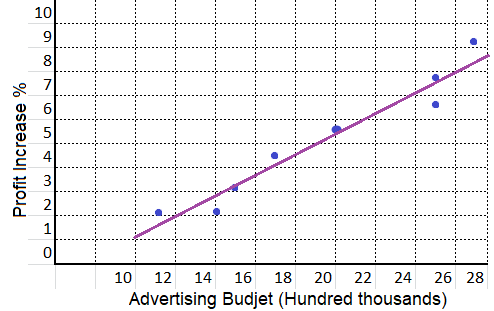
Explanation:
With reference to the above given data set,
m = \(\frac{9.3 – 7.9}{27 – 25}\) = \(\frac{1.4}{2}\) = 0.7
y = \(\frac{1.4}{2}\) x + b
20 = (\(\frac{1.4}{2}\))(5.7) + b
20 – 3.99 = b
b = 20 – 4
b = 16
y = \(\frac{1.4}{2}\) x + 16
y = (0.7)x + 16
Use the data set to complete the frequency table and answer the questions.
Gas mileage of a number of cars was collected as follows: 12, 17, 12, 14, 16, 18, 16, 18, 12, 16, 17, 15, 15, 16, 12, 15, 16, 16, 12, 14, 15, 12, 15, 15, 19, 13, 16, 18, 16, and 14.
Question 10.
Mileage Range: 11.5 – 13.4
Frequency: ______________
Cumulative Frequency: _____________
Relative Frequency: ______________
Answer:
Frequency: 7
Cumulative Frequency: 7
Relative Frequency: 23.3%
Explanation:
The below chart shows that the Gas mileage of a number of cars was collected.
The Gas mileage ranged from the 11.5 to 19.5, with the most frequent mileage in the 15.5 to 17.4 range.
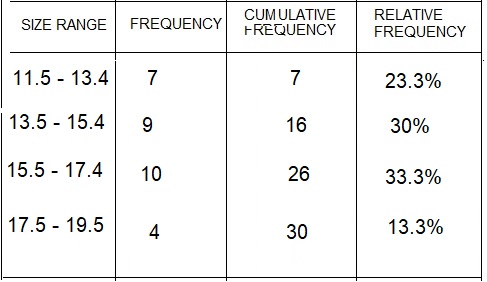
Frequency:
Frequency is the number of occurrences of a repeating event per unit of time.
The range of mileage in 11.5 – 13.4 is 7 times.
So, the frequency is 7.
Cumulative Frequency:
cumulative frequency is the sum of all the frequencies before the size range.
0 + 7 = 7
Relative Frequency:
frequency of the given range ÷ total number of observations.
7/30 = 23.3%
Question 11.
Mileage Range: 13.5-15.4
Frequency: ______________
Cumulative Frequency: _____________
Relative Frequency: ______________
Answer:
Frequency: 9
Cumulative Frequency: 16
Relative Frequency: 30%
Explanation:
The below chart shows that the Gas mileage of a number of cars was collected.
The Gas mileage ranged from the 11.5 to 19.5, with the most frequent mileage in the 15.5 to 17.4 range.

Frequency:
Frequency is the number of occurrences of a repeating event per unit of time.
The range of mileage in 13.5 – 15.4 is 9 times.
So, the frequency is 9.
Cumulative Frequency:
cumulative frequency is the sum of all the frequencies before the size range.
7 + 9 = 16
Relative Frequency:
frequency of the given range ÷ total number of observations.
9/30 = 30%
Question 12.
Mileage Range: 15.5-17.4
Frequency: ______________
Cumulative Frequency: _____________
Relative Frequency: ______________
Answer:
Frequency: 10
Cumulative Frequency: 26
Relative Frequency: 33.3%
Explanation:
The below chart shows that the Gas mileage of a number of cars was collected.
The Gas mileage ranged from the 11.5 to 19.5, with the most frequent mileage in the 15.5 to 17.4 range.

Frequency:
Frequency is the number of occurrences of a repeating event per unit of time.
The range of mileage in 15.5 – 17.4 is 10 times.
So, the frequency is 10.
Cumulative Frequency:
cumulative frequency is the sum of all the frequencies before the size range.
16 + 10 = 26
Relative Frequency:
frequency of the given range ÷ total number of observations.
10/30 = 33.3%
Question 13.
Mileage Range: 17.5-19.4
Frequency: ______________
Cumulative Frequency: _____________
Relative Frequency: ______________
Answer:
Frequency: 4
Cumulative Frequency: 30
Relative Frequency: 13.3%
Explanation:
The below chart shows that the Gas mileage of a number of cars was collected.
The Gas mileage ranged from the 11.5 to 19.5, with the most frequent mileage in the 15.5 to 17.4 range.

Frequency:
Frequency is the number of occurrences of a repeating event per unit of time.
The range of mileage in 17.5 – 19.5 is 4 times.
So, the frequency is 4.
Cumulative Frequency:
cumulative frequency is the sum of all the frequencies before the size range.
26 + 4 = 30
Relative Frequency:
frequency of the given range ÷ total number of observations.
4/30 = 13.3%
Question 14.
How many cars were included in the data set?
Answer:
30
Explanation:
The information given above shows that the Gas mileage of a number of cars was collected.
The total number of cars included in the data set are 30.
Question 15.
What is the most common gas mileage range for this set of cars?
Answer:
15.5 – 17.4
Explanation:
The information given above shows that the Gas mileage of a number of cars was collected.
The Gas mileage ranged from the 11.5 to 19.5, with the most frequent mileage in the 15.5 to 17.4 range.
Question 16.
What is the least common gas mileage range for this set of cars?
Answer:
17.5 – 19.5
Explanation:
The information given above shows that the Gas mileage of a number of cars was collected.
The Gas mileage ranged from the 11.5 to 19.5, the least common gas mileage range for this set of cars is 17.5 – 19.5.